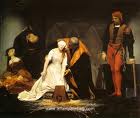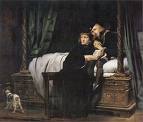
During January and February I was very busy having children. Or I should say I was attendant on the act of birth. (Every time I turn round these days another child has appeared. Where do they all come from? Someone really must explain it to me, but in the meantime I've had my hands full with my one-year-old son and two-month-old daughter.)
For two months I was too busy to read even a single newspaper, but kept receiving them by the bag-load. Whereupon, feeling exhausted and stressed, I proceeded to put bag after bag of newspapers into a large trunk in a room at home I quaintly call 'The Raj Room'. Finally at the end of February I had acquired a quite vast quantity of newspapers. Obsessive compulsion disorder demanded that I finally sit down and over the course of a few days catch up, in entirely random order, on nine weeks of news, features and seemingly endless supplements.
Buried deep in the newspaper mountain was an article on the new exhibition at the National Gallery. It's called 'Painting History: Delaroche and Lady Jane Grey' and runs until 23 May. The exhibition apparently offers a reappraisal of the painter Paul Delaroche (1797-1856), who had sunk into critical oblivion during the twentieth century, but whose painting The Execution of Lady Jane Grey has proved to be one of the most popular amongst all those at the National Gallery.
But, hang on a minute. The title story in the book I published in 2005, The Tower of London, has at its heart precisely this subject. 'The Tower of London'
 is an eerie fantasy meditating on the nature of time and history, where a Japanese visitor to the Tower of London spies the ghost of Lady Jane Grey and the blood-splattered climax of the story is a re-enactment of Delaroche's picture. Not only that, but Soseki actually includes a re-enactment of another Delaroche painting The Princes in the Tower (pictured right) in the same story.
is an eerie fantasy meditating on the nature of time and history, where a Japanese visitor to the Tower of London spies the ghost of Lady Jane Grey and the blood-splattered climax of the story is a re-enactment of Delaroche's picture. Not only that, but Soseki actually includes a re-enactment of another Delaroche painting The Princes in the Tower (pictured right) in the same story. What a pity, I thought, that the organizers of this exhibition had no idea that Delaroche's paintings, and The Execution of Lady Jane Grey in particular, had gone on to inspire a classic work of Japanese literature. What a fascinating coda to the exhibition it would have made if there had been some reference to this. The exhibition apparently notes that Delaroche was influenced by theatre, yet in Soseki's literary rendition, it is almost as if the pictures have been returned to their theatrical setting as he refers to the 'stage of the imagination' and treats the re-enactment of the pictures as scenes of a play. Soseki was fascinated by the interaction of visual and literary arts and in his early work was striving to summon up 'word-paintings', with famous pictures like Delaroche's fused into the fabric of his literary works.
This seemed like too good an opportunity to miss and so I dashed off some emails to the National Gallery. If nothing else, I suggested, would it not be a good idea to pile up some copies of Soseki's Tower of London at the exhibition so visitors could find out for themselves what the intriguing worldwide influence of Delaroche's paintings have been?
Gratifyingly I did receive a nice email from the guest curator, expressing interest in Soseki's story but regretting that she was just about to depart to Italy for three weeks (ah, the life of the fine art critic). Yet following it came the inevitable email from the National Gallery shop explaining that if only they had known about the book they would of course have stocked it, but unfortunately now all the exhibition book budget had been spent and all the shelf space allocated...
While we are on the subject, can someone tell me why they don't sell Soseki's The Tower of London at the shop at the Tower of London (pictured right)? I mean Soseki is the
 most important Japanese writer of the modern age and his story 'The Tower of London' was one of his breakthrough works. There seems however only to be space for books on the history of the Tower of London or Tudor history or pop-up books for children. Trying to persuade the Tower of London shop that they might also have room for a world literary classic and you descend into a Kafkaesque world of bureaucratic jobsworthiness. My dear sir, to have a book sold at the Tower of London shop you must first submit an application to Her Majesty's Palaces, whereupon the book will be scrutinized for its worthiness, suitability and public appeal...and so on and so on.
most important Japanese writer of the modern age and his story 'The Tower of London' was one of his breakthrough works. There seems however only to be space for books on the history of the Tower of London or Tudor history or pop-up books for children. Trying to persuade the Tower of London shop that they might also have room for a world literary classic and you descend into a Kafkaesque world of bureaucratic jobsworthiness. My dear sir, to have a book sold at the Tower of London shop you must first submit an application to Her Majesty's Palaces, whereupon the book will be scrutinized for its worthiness, suitability and public appeal...and so on and so on. Is it really that people don't want to know anything more than endless rehashes of Tudor History? Or are they are simply prevented from finding ways of expanding their knowledge of the world, of seeing the myriad ways in which cultures, and the visual and literary arts, interact? I can't help finding it sad that the only people who get to read the classics of Japanese literature are those on Japanese courses or those with a particular interest in Japan. And yet so many of the stories themselves, like 'The Tower of London', are patently universal in appeal and connect to a multitude of fascinating subjects which have nothing to do with Japan. The only problem is these literary classics are consistently excluded from all the places where you should be able to easily acquire them.
No comments:
Post a Comment